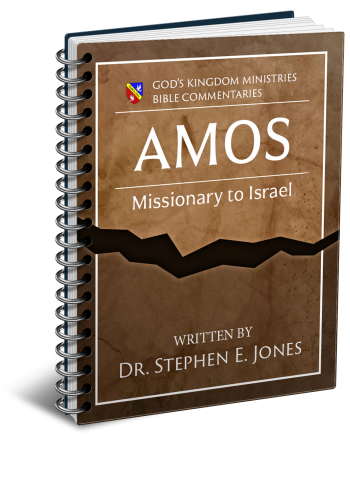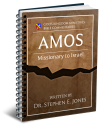Latest Posts
View the latest posts in an easy-to-read list format, with filtering options.

Amos was a missionary from Judah to Israel, giving them a final warning to repent before divine judgment was to destroy the nation. They refused, and two years later the nation was struck by a massive earthquake that destroyed their defenses and allowed the Assyrians to conquer them easily.
Category - Bible Commentaries

Amos 1:6-8 says,
6 Thus says the Lord, “For three transgressions of Gaza and for four I will not revoke its punishment, because they deported an entire population to deliver it up to Edom. 7 So I will send fire upon the wall of Gaza, and it will consume her citadels. 8 I will also cut off the inhabitants from Ashdod, and him who holds the scepter, from Ashkelon; I will even unleash My power upon Ekron, and the remnant of the Philistines will perish,” says the Lord God [Adonai Yahweh].
There were originally five great Philistine cities. In addition to the four that Amos mentions above, there was the city of Gath, best known for its resident giant family, Goliath and his brothers.
Amos does not include Gath in his list of Philistine cities, probably because the city had already been destroyed by King Uzziah of Judah. Recall that Amos prophesied during the reign of Uzziah of Judah and Jeroboam II of Israel.
Uzziah had an army of 307,500 men (2 Chron. 26:13) and built mobile towers for his archers to shoot arrows more effectively at the soldiers on the walls (2 Chron. 26:15). We read in 2 Chron. 26:6,
6 Now he [Uzziah] went out and warred against the Philistines, and broke down the wall of Gath and the wall of Jabneh and the wall of Ashdod, and he built [fortress] cities in the area of Ashdod and among the Philistines.
Gath, which had already been weakened by Hazael who conquered the city around 830 B.C., appears to have been permanently destroyed by Uzziah in the next century.
Jabneh and Ashdod survived and were rebuilt. Jabneh was later known as Jamnia and was the seat of the Jewish Sanhedrin after the destruction of Jerusalem in 70 A.D. Ashdod became known as Azotus, the city where Philip found himself after being transported supernaturally in Acts 8:40 after ministering to the Ethiopian eunuch.
Gath, however, was so totally destroyed that even its location was lost until the 20th century. Archeologists now believe it to be near Tel es-Safi, where they discovered evidence of a huge city gate that suggested the presence of giants.
Gaza was in southern Philistia along the trade route to Egypt. This made it an important slave-trading city. When the Philistines were powerful, they often raided Israelite cities and communities and sold the people into slavery to the Edomites south of Israel. This is Amos’ chief reason for condemning Gaza—“because they deported an entire population to deliver it up to Edom” (Amos 1:6).
Dagon was the chief god of Gaza and of Ashdod. Dagon was the fish god, the equivalent of Neptune, the merman. Dagon’s female counterpart was Atargatis, the mermaid goddess who was worshiped in Ashkelon (located between Gaza and Ashdod). She figures prominently in my fourth novel entitled, Power of the Flame. It is the story of the ministry of Samson. Atargatis is essentially the goddess of Ashkelon who overcame Samson by the power of seduction.
Amos 1:8 also mentions the city of Ekron, where Baal-zebub was worshiped. 2 Kings 1:2 records how Ahaziah, king of Israel, had an accident, falling through the floor of his upper chamber. Instead of inquiring of Yahweh, he told his servants to “Go, inquire of Baal-zebub, the god of Ekron, whether I shall recover from this sickness.”
Elijah chided him for it, saying, “Is it because there is no God in Israel that you are going to inquire of Baal-zebub, the god of Ekron?” (2 Kings 1:3).
Baal-zebub means “Lord of the Flies.” The Jews later altered the name as a parody, calling him Baal-zebul, “Lord of the Dunghill.” (Flies love dunghills!) So we read in the New Testament how the Pharisees made the claim that Jesus cast out demons by the power of Beelzebul. Matt. 12:24 says,
24 But when the Pharisees heard it, they said, “This man casts out demons only by Beelzebul the ruler of the demons.”
Jesus refuted this claim in Matt. 12:26, 27,
26 And if Satan casts out Satan, he is divided against himself; how then shall his kingdom stand? 27 And if I by Beelzebul cast out demons, by whom do your sons cast them out? Consequently, they shall be your judges.
This shows that the common view at the time was to link the “flies” with “demons.” Even as flies swarmed around dunghills, so also demons swarmed around the dunghills of the heart—which are the high places of heart idolatry. (See my book, The Laws of Wormwood and Dung.)
The Scriptures speak of children of God and children of the flesh. A child of the flesh is one ruled by the carnal mind, rather than by genuine revelation of the Spirit. Throughout the history of Israel in the land of Canaan, the idolatrous nations are spiritual types of those children of the flesh. In Rom. 9:8 and in Gal. 4:29, Paul refers to Ishmael as an example of a child of the flesh.
Perhaps the most prominent nation representing the flesh is Philistia. So when Samson fought the Philistines by the power of God, he prophetically pictured the sons of God overcoming the flesh. But when Samson himself was overcome, it was a tragic picture of the way in which even men of faith can succumb to the power of the flesh.
The lesson is that when Israelites (believers) follow the leading of the flesh, or when they place their confidence in the flesh, they give power to the children of the flesh. Then judgment comes, as those fleshly people are given authority over the people of God.
In this case, Amos was gearing up toward his prophecy against Israel and Judah and how they would be judged and deported for being no different from other children of the flesh. But even as the Philistine cities were to be overthrown, so also, in the long run, will heart idolatry itself be eradicated by the New Covenant.